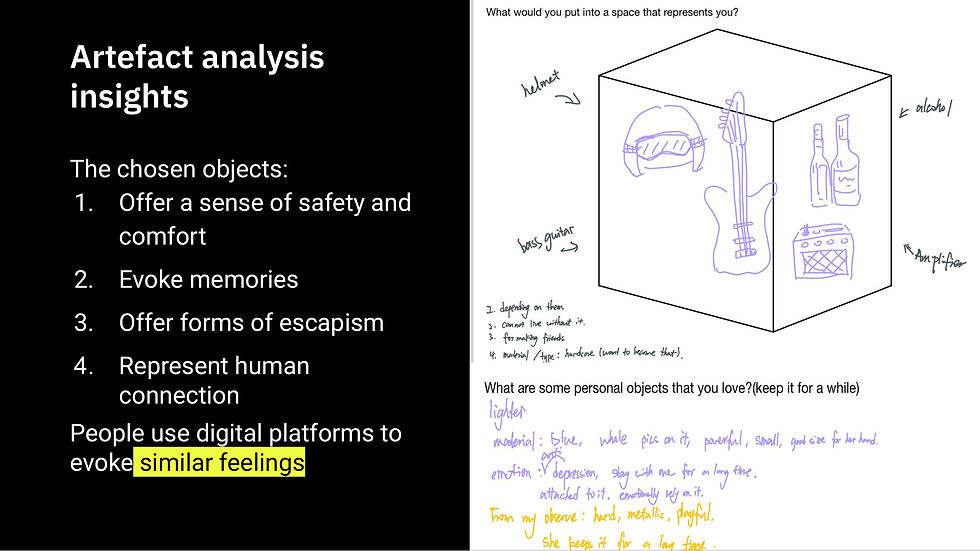UX of Shadows
- Rayanne Ellis
- Jan 4, 2024
- 5 min read
Updated: Jan 13, 2024
Design a physical artefact for measuring digital shadows
Timeframe: Monday 13 November - Sunday 26 November
Team members: Noor, Ivy, Dan, Rayanne
Research methods: Directed Storytelling and Artefact Analysis
Week 1 Monday 13 November - Sunday 19 November
Research and ideation
For our Digital Shadow, we decided to focus on digital footprints over the Internet of Things, due to our better understanding and interest in footprints. We then created a mind map of our ideas and narrowed down to two via a vote:

Fig. 1 mindmap of our ideas the two circled were chosen from the vote. 1. Human barcode 2. The last digital shadow
The next day we looked into these two ideas further and ended up combining thoughts from both to create one, which we refined into a concept.

Fig. 2 Human barcode ideas explored further. The red dots are votes on the ideas

Fig. 3 Last digital shadow ideas explored further.

Fig. 4 combination of the ideas we liked from digital shadows and human barcode.

Fig. 5 refined concept to explore from the ideas.
I then did some secondary research into our concept and found two interesting articles one by Fedorova (2022) for Modem Design Studio. This article highlighted how people experiment with or display their identity online and what influences this. The second article by Winsborough et al (2016) focused on what could be if technology could unite our digital activity with personality, looking at this seven years later I feel with current technology we are in this situation now. From this research and our own ideas we created 4 research questions to explore our concept.
Fig. 6 & 7 pictures of the two articles and quotes from them.
Fig. 8, 9, 10 & 11 the research questions to explore in Directed Storytellig & Artefact Analysis
Directed story telling
We created an interview script with aims, a brief to inform the participant of what we were doing and why and a mix of questions and story telling prompts.
Fig. 12 & 13 directed storytelling script pulling together all our ideas.
We interviewed 5 participants, one of us was the observer taking notes and one the interviewer. We ran a synthesis exercise on our our findings and gained the following insights

Fig. 14 Images of Storytelling sessions. We worked in pairs, one facilitated and the other took notes. We took it in turns to ensure we all experienced both roles.

Fig. 15 Synthesis exercise to create themes from our findings
Fig. 16, 17, 18 & 19 the four key finds from our storytelling interviews.
Artefact analysis
We agreed to ‘Identify physical artefacts people care about as part of their identity and analyse these artefacts.’ To obtain tangible insights into individuals' sense of self.
To prepare, we designed research questions to seek out artefacts people cared about and practiced artefact analysis as a group on Dan's keys. Finally, we each led a sessions with selected participants and analysed all our outputs collectively.

Fig. 20 Research questions and answers from my sessions to identify artefacts

Fig. 21 Artefact analysis of two objects identified from my research above

Fig. 22 Our collective findings from Artefact Analysis and a picture of Ivy’s Artefact Analysis session.
What I learnt
Directed storytelling
Our directed story telling script provided focus for the interviews, however, it was too large and resulted in each session having slightly different questions asked, making our findings difficult to compare.
I also found the storytelling interviews were time consuming to facilitate and analyse, causing the findings to be rich but limited to a small sample size. I think we could have done some additional secondary research to cross check assumptions and back up insights.
Artefact analysis
Not all outcomes from this method were useful to our research questions. I think a different method that involved observing people in the real world and online could have helped us explore our research questions better, as we may have been able to observe pattern in peoples behaviour they are not consciously aware of.
Presentation
Our presentation provided a clear story of what we wanted to explore and how we got there. Guest More Bakal said our research questions were excellent and provided focus. However, other feedback highlighted we had lost the human barcode aspect during our concept evolution and posed the question how could we bring this back?
Week 2 Monday 20 November - Sunday 26 November
Ideation
Due to conflicting schedules we collaborated on ideas remotely by sharing videos explaining each of our ideas. Although we knew we wanted to focus on the fragmented personalities finding from Storytelling, we still had too many ideas. It took us a long time to narrow down to one concept.

Fig. 23 a few of the ideas we came up with throughout our ideation process
Fig. 25 videos we shared with each other about our ideas

Fig. 25 a rough outline of our final concept
Barcode research
I researched into barcodes and found they were possibly one of the first ways objects have been given digital shadows. I also found humans are increasingly being scanned like a barcode to convert them into digital beings, we wanted to represent this in our physical artefact.

Fig. 26 barcode research
Building the User Experience
We split up the tasks to build the experience. I created the 'shadow boards' for participants to fill out and understand their digital shadows. We wanted the participant to fill out the boards digitally with icons however, we changed this to writing because we felt icons were not expressive enough.
I facilitated the session with a voluntary participant. Given the personal nature of this request - share their recommendations from digital/social platforms, I made an effort to explain the research and how the output would be used, giving them multiple chances to opt out. We all converted these 'shadow boards' into digital shadow barcode projections. Dan build the physical artefact a scanner to scan the participant and reveal their barcode, Noor created the projection and Ivy, Fatema and I created the presentation.

Fig. 27 participant filling out digital shadow boards
Fig. 28, 29, 30 & 31 participant’s outcomes
Fig. 32, 33, 34, 35 & 36 the digital barcodes of the participants digital shadow boards.

Fig. 37 the physical artefact, the scanner Dan built
Fig. 38 video of myself testing final concept
Fig. 39 close up video of final concept
What I learnt
Way of working
We had a good blend of independent, asynchronous and collective working approaches to get to our final outcome. As a result we were broadly efficient, clear on our tasks and able to give fresh perspective to each other work.
Digital boards
If I was to do the 'digital board' exercise again I’d give participants more ways to express themselves. For example, ability to add sounds, images, stickers. I’d also have recorded the sessions to listen back and capture anything I missed.
Presentation feedback
It was highlighted this was a diagetic concept that doesn’t currently live in the real world, we therefore, should consider where this experience could exist. For example, could it be used in speed dating for people to see others digital shadows and decide if they match? Could it be a private experience or one that's done with others? Lastly, the barcode lines could have had more meaning. For example, different sized lines could represent what the user felt was accurate. Finally we were praised for the visual impactful effect, the connection to barcodes and the handling of the ethics for the participant.
References
Modem and Fabricant (2023) Our Digital Selves. No.07. Available at: https://modemworks.com/research/our-digital-selves/ (Accessed 11/01/2024)
Shah, S. (2023) 'Wordcoin: OpenAI founder’s eye-scanning crypto project launches in London', The Standard, 24 July. Available at: https://www.standard.co.uk/news/tech/worldcoin-sam-altman-openai-founder-london-eye-scan-crypto-b1096294.html (Accessed 11/01/2024)
Weightman, G. (2015) Eureka: How Invention Happens. Available at: https://play.google.com/store/books/details/Gavin_Weightman_Eureka?id=1EUJCgAAQBAJ
Winsborough, D., Lovric, D., Chamorro-Premuzic, T. (2016) 'Personality, privacy and our digital selves', The Guardian, 18 July. Available at: https://www.theguardian.com/media-network/2016/jul/18/personality-privacy-digital-selves (Accessed 11/01/2024)












































